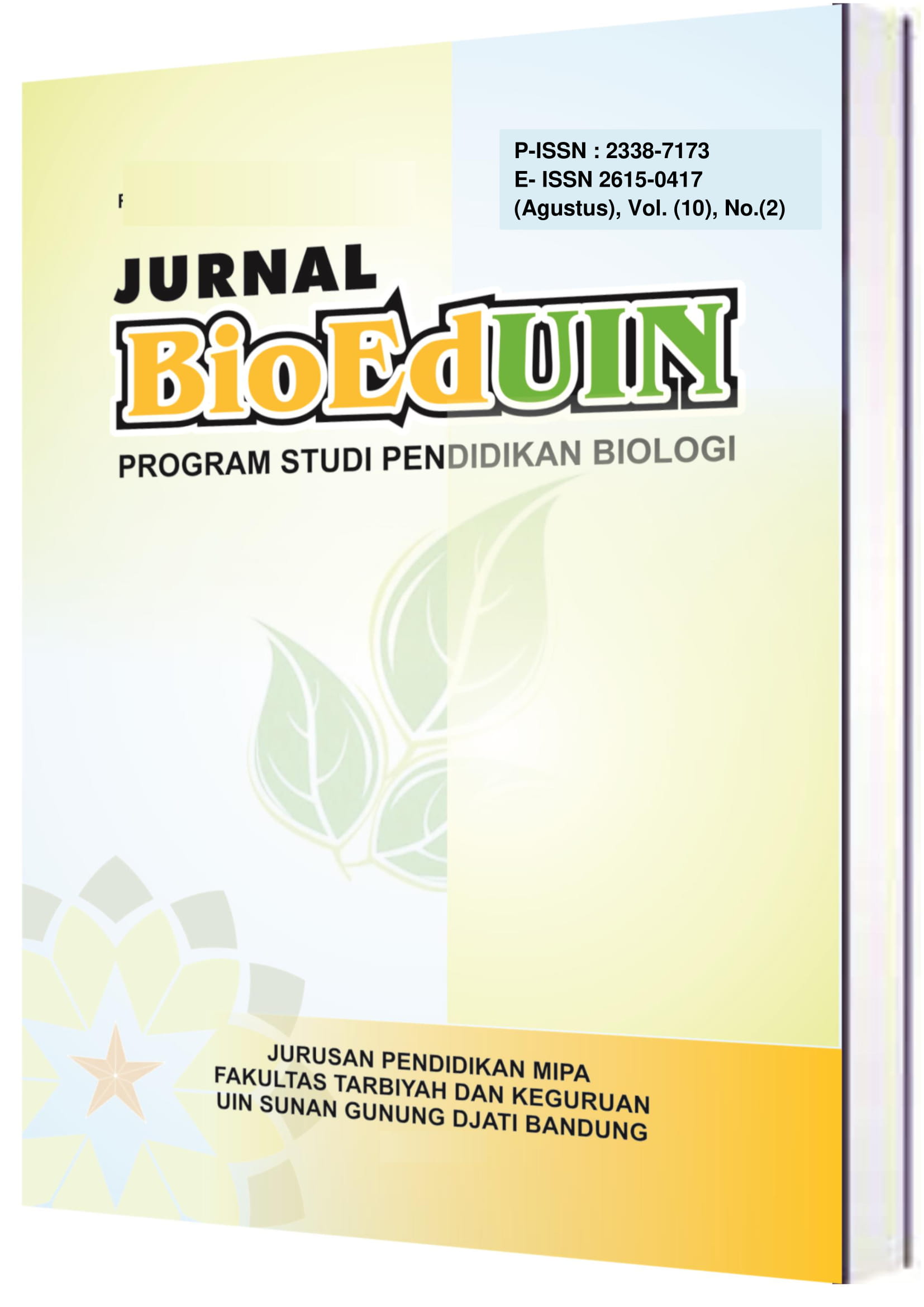KONSTRUKSI LINGKUNGAN BELAJAR DAN KETERAMPILAN BERPIKIR KRITIS MAHASISWA PADA MATA KULIAH BIOLOGI UMUM
DOI:
https://doi.org/10.15575/bioeduin.v10i2.12085Keywords:
learning environment, critical thinking skillsAbstract
environment and critical thinking skills of Biology Education students in general biology
courses. The sample of research was 110 Biology Education students who contracted General
Biology courses. The instrument used question of critical thinking skill by Ennis and the
constructivist learning environment survey (CLES) by Fisher. Data analysis using Pearson
correlation. The results obtained the highest average score on the Basic support indicator of
5.34 and the lowest average on the Strategy and tactics indicator with of 2.99. On
constructivist learning environment survey the highest average score on the Student
negotiation factor was 23.80 and the lowest score was on the Shared control factor of 16.50.
Pearson correlation test results showed a significance value of 0.143> 0.05 that mean there
was no correlation between variables. There is no relationship between the learning
environment and critical thinking skills of Biology Education students in general biology
courses. The reason for the lack of critical thinking skills and the construction of the learning
environment is that students are not right in using their cognitive strategies.
References
Ahmad, C. N. C., Ching, W. C., Yahaya, A.,
& Abdullah, M. F. N. L. (2015).
Relationship between Constructivist
Learning Environments and
Educational Facility in Science
Classrooms. Procedia - Social and
Behavioral Sciences, 191, 1952–1957.
https://doi.org/10.1016/j.sbspro.2015.04
.672
Aldridge, J. M., Fraser, B. J., Taylor, P. C.,
& Chen, C. C. (2000). Constructivist
learning environments in a
crossnational study in Taiwan and
Australia. International Journal of
Science Education, 22(1), 37–55.
https://doi.org/10.1080/0950069002899
Bailin, S., Case, R., Coombs, J. R., &
Daniels, L. B. (1999). Common
misconceptions of critical thinking.
Journal of Curriculum Studies, 31(3),
–283.
https://doi.org/10.1080/0022027991831
Cheng, M. H. M., & Wan, Z. H. (2017).
Exploring the effects of classroom
learning environment on critical
thinking skills and disposition: A study
of Hong Kong 12th graders in Liberal
Studies. Thinking Skills and Creativity,
, 152–163.
https://doi.org/10.1016/j.tsc.2017.03.00
Deieso, D., & Fraser, B. J. (2019). Learning
environment, attitudes and anxiety
across the transition from primary to
secondary school mathematics.
Learning Environments Research,
(1), 133–152.
https://doi.org/10.1007/s10984-018-
-5
Ennis, R. H. (1996). Critical Thinking. New
Jersey: Prentice-Hall, Inc.
Garcia, T., & Pintrich, P. R. (1992). Critical
Thinking and Its Relationship to
Motivation, Learning Strategies, and
Classroom Experience.
Gredler, M. (2009). Learning and
Instruction: Theory into Practice (Sixth
Edit). New Jersey: Pearson.
Higgins, S., Hall, E., Baumfield, V.,
Moseley, D., Senior, V. B.,
Butterworth, M., … Gregson, M.
(2005). A Meta-analysis of the impact
of the Implementation of thinking skills
approaches on pupils. Retrieved from
Hmelo-Silver, C. E., Duncan, R. G., &
Chinn, C. A. (2007). Scaffolding and
achievement in problem-based and
inquiry learning: A response to
Kirschner, Sweller, and Clark (2006).
Educational Psychologist. Routledge.
https://doi.org/10.1080/0046152070126
Kwan, Y. W., & Wong, A. F. L. (2015).
Effects of the constructivist learning
environment on students’ critical
thinking ability: Cognitive and
motivational variables as mediators.
International Journal of Educational
Research, 70, 68–79.
https://doi.org/10.1016/j.ijer.2015.02.00
Lau, J., & Chan, J. (2019). [C01] What is
critical thinking?
Nix, R. K., Fraser, B. J., & Ledbetter, C. E.
(2005). Evaluating an Integrated
Science Learning Environment Using
The Constructivist Learning
Environment Survey. Learning
Environments Research, 8, 109–133.
https://doi.org/10.1007/s10984-005-
-x
Pressley, M., Borkowski, J. G., & Schneider,
W. (1987). Cognitive Strategies: Good
Strategy Users Coordinate
Metacognition and Knowledge.
Retrieved October 24, 2019.
Raja, S. (2016). Associations Between
Learning Environment and Students’
Attitudes and Understanding of Nature
of Science. Curtin University.
Schunk, D. H., Columbus, B., New, I., San,
Y., Upper, F., River, S., … Tokyo, T.
(2012). Learning Theories An
Educational Perspective Sixth Edition.
Sternberg, R. J. (2003). Wisdom,
Intelligence, and Creativity
Synthesized. New York: Cambridge
University Press.
Taylor, P. C., Fraser, B. J., & Fisher, D. L.
(1997). Monitoring constructivist
classroom learning environments.
International Journal of Educational
Research, 27(4), 293–302.
https://doi.org/10.1016/S0883-
(97)90011-2
Velayutham, S., Aldridge, J., & Afari, E.
(2013). Students’ learning environment,
motivation and self-regulation: A
comparative structural equation
modeling analysis. Application of
Structural Equation Modeling in
Educational Research and Practice,
(April 2015), 115–133.
https://doi.org/10.1007/978-94-6209-
-4
Downloads
Published
How to Cite
Issue
Section
Citation Check
License
Authors who publish in Jurnal BIOEDUIN agree to the following terms:
- Authors retain copyright and grant the journal right of first publication with the work simultaneously licensed under a Attribution-ShareAlike 4.0 International (CC BY-SA 4.0) License that allows others to share the work with an acknowledgment of the work's authorship and initial publication in this journal.
- Authors are able to enter into separate, additional contractual arrangements for the non-exclusive distribution of the journal's published version of the work (e.g., post it to an institutional repository or publish it in a book), with an acknowledgment of its initial publication in this journal.
- Authors are permitted and encouraged to post their work online (e.g., in institutional repositories or on their website) prior to and during the submission process, as it can lead to productive exchanges, as well as earlier and greater citation of published work (See The Effect of Open Access).









